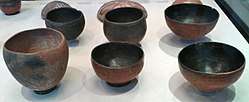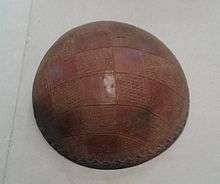A-Group culture
The A-Group culture was an ancient civilization that flourished between the First and Second Cataracts of the Nile in Nubia. It lasted from c. 3800 BCE to c. 3100 BCE.[1]
Overview

In 1907, the Egyptologist George A. Reisner first discovered artifacts belonging to the A-Group culture.[2] Early hubs of this civilization included Kubaniyya in the north and Buhen in the south, with Aswan, Sayala, Toshka and Qustul in between.[1]
The A-Group makers maintained commercial ties with the Ancient Egyptians. They traded commodities like incense, ebony and ivory, which were gathered from the southern riverine area. They also bartered carnelian from the Western Desert as well as gold mined from the Eastern Desert in exchange for Egyptian products, olive oil and other items from the Mediterranean basin.[1]
Excavations at an A-Group cemetery in Qustul yielded an old incense burner, which was adorned with Ancient Egyptian royal iconography. However, further research established the antecedence of the predynastic Egyptian regalia:
The earliest known examples of Egyptian royal iconography, such as, e.g., the representation of the Red Crown on a late Naqada I (c. 3500 BC) pottery vessel from Abydos or the triumphal scenes in the painting from Hierakonpolis Tomb 100 (c. 3400-3300 BC) are much older than the Qustul censer. It seems thus that it was the Qustul rulers who adopted symbols of royal authority developed in Egypt and not vice versa.[3]
More recent and broader studies have determined that the distinct pottery styles, differing burial practices, different grave goods and the distribution of sites all indicate that the Naqada people and the Nubian A-Group people were from different cultures. Kathryn Bard further states that "Naqada cultural burials contain very few Nubian craft goods, which suggests that while Egyptian goods were exported to Nubia and were buried in A-Group graves, A-Group goods were of little interest further north."[4]

The A-Group makers left behind a number of cemeteries, with each necropolis containing around fifty graves. Most of what is known about this culture has been gleaned from these tombs, over 3,000 of which have been excavated. The burials are of two kinds: a more common oval pit, and a similar pit featuring a lateral funerary niche. Skeletons found within these graves were observed to be physically akin to their peers in Upper Egypt. The specimens typically had straight hair of a black or dark brown hue. On average, the men were 169.9 cm in height and the women stood around 155.5 cm. Some individuals were wrapped in leather and positioned on reed mats. All of the tombs contained various burial items, including personal ornaments, utensils and ceramics.[5] The A-Group culture came to an end around 3100 BCE, when it was destroyed, apparently by the First Dynasty rulers of Egypt.[1]
Dental trait analysis of A-Group fossils found affinities with populations inhabiting Northeast Africa the Nile valley, and East Africa. Among the sampled populations, the A-Group people were nearest to the Kerma culture bearers and Kush populations in Upper Nubia and to Ethiopians, followed by the Meroitic, X-Group and Christian period inhabitants of Lower Nubia and the Kellis population in the Dakhla Oasis, as well as C-Group and Pharaonic era skeletons excavated in Lower Nubia and ancient Egyptians (Naqada, Badari, Hierakonpolis, Abydos and Kharga in Upper Egypt; Hawara in Lower Egypt).[6]
The linguistic affinity of the A-Group culture is unknown, but, according to Claude Rilly, it is unlikely to have spoken a language of the Northern East Sudanic branch of Nilo-Saharan. Beyond this Rilly states that "the range of possibilities remains wide" and includes: a language belonging to another (non-Northern East Sudanic) branch of the Nilo-Saharan family, a Cushitic language, or other Afro-Asiatic language.[7]
B-Group culture
Reisner originally identified a B-Group culture, however this theory became obsolete when H.S. Smith demonstrated that the "B-Group" was an impoverished manifestation of the A-Group culture.[8]
References
- "Ancient Nubia: A-Group 3800–3100 BC". The Oriental Institute. Retrieved 1 July 2016.
- Shinnie, Peter L. (2013). Ancient Nubia. Routledge. p. 43. ISBN 1136164650. Retrieved 30 June 2016.
- Török, László. Between Two Worlds : The Frontier Region Between Ancient Nubia and Egypt, 3700 BC-AD 500. In Probleme Der Ägyptologie. Leiden: Brill. 2009. ISBN 9789004171978
- An Introduction to the Archaeology of Ancient Egypt, by Kathryn A. Bard, 2015, p. 110
- Shinnie, Peter L. (2013). Ancient Nubia. Routledge. p. 50. ISBN 1136164650. Retrieved 30 June 2016.
- Haddow, Scott Donald. "Dental Morphological Analysis of Roman Era Burials from the Dakhleh Oasis, Egypt". Institute of Archaeology, University College London. Retrieved 2 June 2017.
- Raue, Dietrich (2019-06-04). Handbook of Ancient Nubia. Walter de Gruyter GmbH & Co KG. p. 134. ISBN 978-3-11-042038-8.
- H.S. Smith, The Nubian B-Group, in: Kush 14,1966: pp. 69-124.
External links
- Early States and the A-Group 'Proto-Kingdom'
- Regional variations in the so-called “A-Group” Culture of Lower Nubia
- Hans-Åke Nordstrom : The Nubian A-Group
- Maria Gatto: Hunting for the Exclusive Nubian A-Group People; Renée Friedman: Setting the Scene
- Nubian Cultures: A and C-Group
- Early Burials: A-Group and C-Group
- The Exhibit of Nubian Antiquities
- Nancy C. Lovell: Nubian A- and C-Groups
- Maria Carmela Gatto: The Nubian A-group: a reassessment